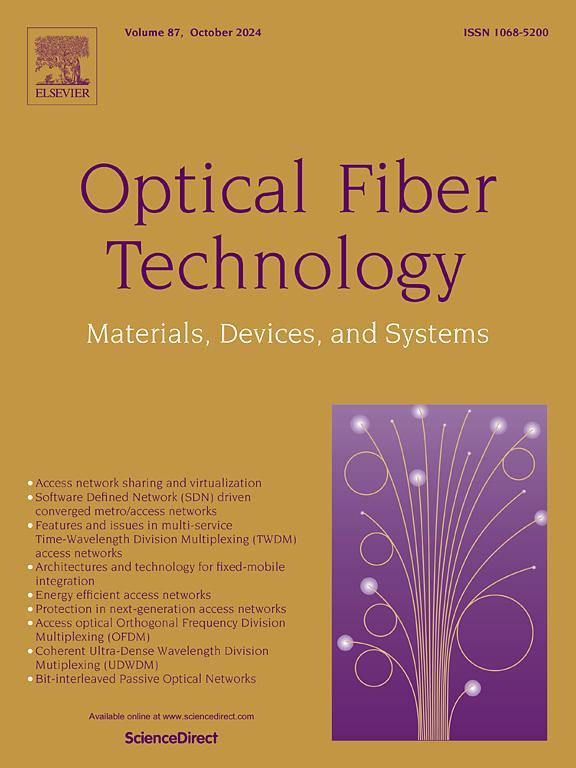MOF-based fiber-optic iodine vapor vernier sensor with temperature crosstalk reduction by TOC&TEC
IF 2.7
3区 计算机科学
Q2 ENGINEERING, ELECTRICAL & ELECTRONIC
引用次数: 0
Abstract
Monitoring of iodine vapor during spent fuel reprocessing plays an important role in nuclear safety and environmental health. In this article, we proposed a temperature insensitive fiber-optic vernier sensor based on dual Fabry-Perot interferometer (FPI) for trace detection of iodine vapor in 0°C-80°C. The sensing structure adopts a single-mode fiber (SMF)-hollow-core fiber (HCF)-polymer waveguide structure, which adjusts the spectrum by controlling the ratio of the air cavity length to the polymer waveguide length. The polymer waveguide uses polycarbonate (PC) and polyamide (PA) as composite matrix, doped with N-functionalized metal–organic frame material UiO-66-PYDC to achieve specific recognition and capture of iodine vapor. The research results indicate that the sensitivity of the sensor for detecting iodine vapor is 77.76 pm/ppb, and the detection accuracy reaches 10 ppb in actual calibration. Meanwhile, due to the matching of thermal optical coefficient (TOC, decrease) and thermal expansion coefficient (TEC, increase) of the mixed matrix, the influence of temperature on the optical path of the polymer waveguide is weakened, and the temperature sensitivity is as low as −3.35 pm/°C. Due to the similar chemical properties of iodine isotopes, this work is not only a pioneering attempt to use optical fiber sensors to detect iodine vapor, but also has a promising application in the monitoring of radioactive iodine waste gas in nuclear industry.
TOC&TEC基于mof的温度串扰减小型光纤碘蒸气游标传感器
乏燃料后处理过程中碘蒸气的监测对核安全和环境健康具有重要意义。本文提出了一种基于双法布里-珀罗干涉仪(FPI)的温度不敏感光纤游标传感器,用于检测0°C-80°C的痕量碘蒸气。传感结构采用单模光纤(SMF)-空心芯光纤(HCF)-聚合物波导结构,通过控制空腔长度与聚合物波导长度的比值来调节光谱。该聚合物波导以聚碳酸酯(PC)和聚酰胺(PA)为复合基体,掺杂n功能化金属-有机框架材料UiO-66-PYDC,实现对碘蒸气的特异性识别和捕获。研究结果表明,该传感器检测碘蒸气的灵敏度为77.76 pm/ppb,实际标定时检测精度达到10 ppb。同时,由于混合基体的热光学系数(TOC,减小)和热膨胀系数(TEC,增大)的匹配,温度对聚合物波导光路的影响减弱,温度灵敏度低至- 3.35 pm/°C。由于碘同位素具有相似的化学性质,本工作不仅是利用光纤传感器检测碘蒸气的开创性尝试,而且在核工业放射性碘废气的监测中具有广阔的应用前景。
本文章由计算机程序翻译,如有差异,请以英文原文为准。
求助全文
约1分钟内获得全文
求助全文
来源期刊

Optical Fiber Technology
工程技术-电信学
CiteScore
4.80
自引率
11.10%
发文量
327
审稿时长
63 days
期刊介绍:
Innovations in optical fiber technology are revolutionizing world communications. Newly developed fiber amplifiers allow for direct transmission of high-speed signals over transcontinental distances without the need for electronic regeneration. Optical fibers find new applications in data processing. The impact of fiber materials, devices, and systems on communications in the coming decades will create an abundance of primary literature and the need for up-to-date reviews.
Optical Fiber Technology: Materials, Devices, and Systems is a new cutting-edge journal designed to fill a need in this rapidly evolving field for speedy publication of regular length papers. Both theoretical and experimental papers on fiber materials, devices, and system performance evaluation and measurements are eligible, with emphasis on practical applications.
 求助内容:
求助内容: 应助结果提醒方式:
应助结果提醒方式:


